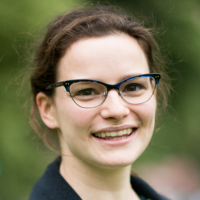By this point in the school year, I hope that you have heard of NCSE’s Scientist in the Classroom program. But if not, please check it out!
In designing the program, we wanted to be sure that scientists and teachers were able to work together to come up with a hands-on activity that fit in with what was going on in the classroom as opposed to a prescribed activity. A really neat result of this design is that all of the pairs have a unique experience with the program.
Here I am featuring one pair that participated in the program during our pilot year, NCSEteacher and NCSE advisory board member David Amidon and scientist Laura Schoenle.
 David Amidon has been teaching eighth grade science in central New York for almost 20 years. In that time, he has taught all of the science disciplines at the middle school level, including chemistry, physics, and earth science. For the past five years, he has been teaching biology and life science with an emphasis on environmental science. David was recently awarded a 2016 Presidential Award for Environmental Educators, presented by the Environmental Protection Agency. This is a great recognition of David’s dedication to teaching students about human impacts on the environment. You can read more about his award here.
David Amidon has been teaching eighth grade science in central New York for almost 20 years. In that time, he has taught all of the science disciplines at the middle school level, including chemistry, physics, and earth science. For the past five years, he has been teaching biology and life science with an emphasis on environmental science. David was recently awarded a 2016 Presidential Award for Environmental Educators, presented by the Environmental Protection Agency. This is a great recognition of David’s dedication to teaching students about human impacts on the environment. You can read more about his award here.
Last spring, David applied for NCSE’s Scientist in the Classroom program, and was matched with Laura, an ecophysiologist who studies the physiological and behavioral responses of animals to environmental challenges.
Laura is currently pursuing her Ph.D. at Virginia Tech University and was a visiting graduate student at Cornell University when she was paired with David’s class.
 For the first visit, Laura showed up with nets, tags and the other instruments of her trade and and demonstrated what scientists do when they are out bird collecting. Students then watched videos of animals engaging in unknown behaviors and began formulating their own hypotheses as to what was going on—a first-hand experience of how science works.
For the first visit, Laura showed up with nets, tags and the other instruments of her trade and and demonstrated what scientists do when they are out bird collecting. Students then watched videos of animals engaging in unknown behaviors and began formulating their own hypotheses as to what was going on—a first-hand experience of how science works.
Later in the semester, Laura returned to the classroom to help David with an activity exploring allele frequency of sickle cell anemia and malaria resistance. Laura also stuck around to discuss her career path with many students after school.
David’s students really enjoyed working with Laura. He noted that “students were able to see a future in science, which was helpful, especially for girls.”
As for Laura, she said, “I was really surprised by the fact that the students did envision scientists as all older, white men who worked over bubbling test tubes. I'd thought that things have come a bit further than that. After working with the students, I believe they had a better sense of the diversity of people in science and gained perspective on the range of activities scientists engage in.”
NCSE created the Scientist in the Classroom project because teachers told us that it would help them teach evolution and climate change with more confidence. We hoped that the program would also provide students with access to scientific role models. In this case, it looks like both goals were met!
We have 36 teacher-scientist partnerships under way this semester, so I will soon have many more stories to tell. If you are interested in participating in this program, please apply here.

